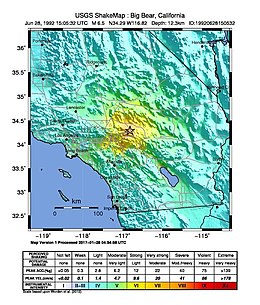1992 Big Bear earthquake

 | |
| UTC time | 1992-06-28 15:05:33 |
|---|---|
| ISC event | 289115 |
| USGS-ANSS | ComCat |
| Local date | June 28, 1992 |
| Local time | 08:05:33 PDT |
| Magnitude | 6.5 Mw[1] |
| Depth | 3.1 miles (5 km)[2] |
| Epicenter | 34°17′N 116°49′W / 34.29°N 116.82°W[2] |
| Type | Strike-slip[2] |
| Areas affected | Inland Empire Southern California United States |
| Total damage | ≥$60 million[3] |
| Max. intensity | MMI VIII (Severe)[4] |
| Foreshocks | 5.2 Mw June 28 at 14:43[5] |
| Aftershocks | 5.3 Mw July 9 at 01:43[5] 5.2 Mw Nov 27 at 16:00[5] 5.1 Mw Dec 4 at 02:08[5] |
| Casualties | 63 injuries[3] |
The 1992 Big Bear earthquake occurred at 08:05:33 PDT on June 28 in Big Bear Lake, California, with a moment magnitude of 6.5 and a maximum perceived intensity of VIII (Severe) on the Mercalli intensity scale. The earthquake occurred at a relatively shallow depth of 5 kilometers (3.1 mi).
Earthquake
[edit]The Big Bear earthquake happened east of Los Angeles, and 3 hours 8 minutes after the M 7.3 1992 Landers earthquake occurred 22 miles (35 km) to the east. It was first believed to be an aftershock of the larger event. However, the United States Geological Survey determined that it was a separate, but related, shock. The two events are considered a regional sequence, rather than a main shock and aftershock. They were part of a complex pattern of regional stress adjustment that also led to the 1999 Hector Mine earthquake.[6]
Damage
[edit]In the Big Bear area, severe damage was reported. Roughly 2,600 chimneys were destroyed, 20 homes were knocked off their foundations, and many unreinforced masonry structures partially or completely collapsed.[7] Ruptured gas pipelines and dislodged fuel tanks caused by the tremor sparked fires that destroyed additional structures.[3] The earthquake also caused landslides in the San Bernardino Mountains,[8] blocking several roadways and creating dust clouds that led many to believe forest fires were occurring.[7] The Stanfield Cutoff was heavily damaged, and had to be closed for several days for repairs.[3]
Marilyn Quayle, wife of then-Vice President Dan Quayle, toured the damage in Big Bear.[3] In total, approximately 40 percent of structures in the Big Bear area suffered some degree of damage,[7] amounting to more than $60 million in losses. 63 injuries were attributed to this earthquake, most of which were minor.
See also
[edit]References
[edit]- ^ ISC (January 19, 2015), ISC-GEM Global Instrumental Earthquake Catalogue (1900–2009), Version 2.0, International Seismological Centre
- ^ a b c PAGER-CAT Earthquake Catalog, Version 2008_06.1, United States Geological Survey, September 4, 2009
- ^ a b c d e Eland, Ron (June 27, 2012). "Shake, rattle and roll: 20 years later". Big Bear Grizzly. Retrieved November 15, 2019.
- ^ M6.5 – Southern California, United States Geological Survey
- ^ a b c d Jones, L. E.; Hough, S. E. (1995), "Analysis of broadband records from the 28 June 1992 Big Bear earthquake: Evidence of a multiple-event source" (PDF), Bulletin of the Seismological Society of America, 85 (3): 690, Bibcode:1995BuSSA..85..688J, doi:10.1785/BSSA0850030688, S2CID 40788625
- ^ Parsons, Tom; Dreger, Douglas S. (July 1, 2000). "Static-stress impact of the 1992 Landers earthquake sequence on nucleation and slip at the site of the 1999 M=7.1 Hector Mine earthquake, southern California". Geophysical Research Letters. 27 (13): 1949–1952. Bibcode:2000GeoRL..27.1949P. doi:10.1029/1999GL011272. S2CID 49218075.
- ^ a b c "The Landers / Big Bear Earthquakes of June 28, 1992". John A. Martin & Associates, Inc. Archived from the original on June 3, 2002.
- ^ "Big Bear Earthquake". Southern California Earthquake Center. Archived from the original on June 18, 2012. Retrieved May 23, 2012.
External links
[edit]- M 6.3 – 7km SSE of Big Bear City, CA – United States Geological Survey
- The International Seismological Centre has a bibliography and/or authoritative data for this event.
